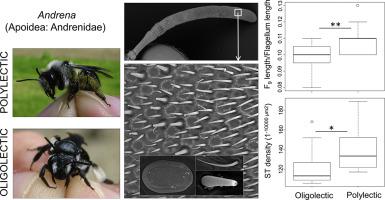当前位置:
X-MOL 学术
›
Arthropod Struct. Dev.
›
论文详情
Our official English website, www.x-mol.net, welcomes your feedback! (Note: you will need to create a separate account there.)
Antennal morphology and sensillar equipment vary with pollen diet specialization in Andrena bees.
Arthropod Structure & Development ( IF 2 ) Pub Date : 2020-05-12 , DOI: 10.1016/j.asd.2020.100950 Carlo Polidori 1 , Alberto Jorge 2 , Concepción Ornosa 3
Arthropod Structure & Development ( IF 2 ) Pub Date : 2020-05-12 , DOI: 10.1016/j.asd.2020.100950 Carlo Polidori 1 , Alberto Jorge 2 , Concepción Ornosa 3
Affiliation

|
Several studies recently reported that specialized (oligolectic) bees, which collect pollen from few host plants, use, besides visual cues, specific volatiles to find their hosts. Generalist (polylectic) bees, on the other hand, likely have to recognize a wider range of volatiles because they forage on many plant species. Bee antennal sensory equipment may thus be under selection to optimize plant host recognition. This selection may have led to variation in sensory equipment morphology with diet specialization (lecty). We tested if lecty correlates with antennal morphology and abundance of the main olfactory/gustatory sensilla (sensilla trichoidea (ST), placoidea (SP), sensilla basiconica (SB)) in the genus Andrena (Hymenoptera: Andrenidae). Across 24 species, and after having controlled for body size, we found polylectic species to have a longer and narrower flagellomer F9 (the one with highest abundance of sensilla), and to have a greater ST density on F9, compared with oligolectic species. Neither SP density nor SB number varied with lecty. A cluster analysis furthermore depicted groups of species that reasonably reflect diet specialization. Our results are in line with the previously observed lower number of glomeruli in the brain of oligolectic, compared with polylectic, bees. A formal correction for phylogeny is necessary to confirm our preliminary conclusion that pollen diet specialization has driven the morphology of the peripheral sensory system in this bee genus.
中文翻译:

触角形态和感官设备随花粉饮食专长而改变。
最近的几项研究报告称,从很少的寄主植物中收集花粉的特殊(低聚)蜜蜂,除了视觉线索外,还使用特定的挥发物来寻找其寄主。另一方面,通才(多电)蜜蜂可能必须识别更大范围的挥发物,因为它们在许多植物物种上觅食。因此,可以选择蜜蜂触角感觉设备来优化植物宿主的识别。这种选择可能导致饮食专业化(电性)导致感觉设备形态发生变化。我们测试了选民是否与Andrena属(膜翅目:Andrenidae)的触角形态和主要嗅觉/味觉感觉器(感觉器Trichoidea(ST),placoidea(SP),basiconica(SB))相关。在控制了体型之后,跨越了24种,我们发现,与低聚物种相比,多聚物种具有更长和更窄的鞭毛体F9(感官丰度最高的物种),并且F9上的ST密度更高。SP密度和SB数均未随选择变化。聚类分析还描绘了合理反映饮食专长的物种组。我们的研究结果与以前观察到的相比,低聚蜂的寡聚寡核苷酸大脑中的肾小球数目更低。需要正式的系统发育校正,以确认我们的初步结论,即花粉饮食的专业化已经驱动了该蜜蜂属的周围感觉系统的形态。SP密度和SB数均未随选择变化。聚类分析还描绘了合理反映饮食专长的物种组。我们的研究结果与以前观察到的相比,低聚蜂的寡聚寡核苷酸大脑中的肾小球数目更低。需要正式的系统发育校正,以确认我们的初步结论,即花粉饮食的专业化已经驱动了该蜜蜂属的周围感觉系统的形态。SP密度和SB数均未随选择变化。聚类分析还描绘了合理反映饮食专长的物种组。我们的研究结果与以前观察到的相比,低聚蜂的寡聚寡核苷酸大脑中的肾小球数目更低。需要正式的系统发育校正,以确认我们的初步结论,即花粉饮食的专业化已经驱动了该蜜蜂属的周围感觉系统的形态。
更新日期:2020-05-12
中文翻译:

触角形态和感官设备随花粉饮食专长而改变。
最近的几项研究报告称,从很少的寄主植物中收集花粉的特殊(低聚)蜜蜂,除了视觉线索外,还使用特定的挥发物来寻找其寄主。另一方面,通才(多电)蜜蜂可能必须识别更大范围的挥发物,因为它们在许多植物物种上觅食。因此,可以选择蜜蜂触角感觉设备来优化植物宿主的识别。这种选择可能导致饮食专业化(电性)导致感觉设备形态发生变化。我们测试了选民是否与Andrena属(膜翅目:Andrenidae)的触角形态和主要嗅觉/味觉感觉器(感觉器Trichoidea(ST),placoidea(SP),basiconica(SB))相关。在控制了体型之后,跨越了24种,我们发现,与低聚物种相比,多聚物种具有更长和更窄的鞭毛体F9(感官丰度最高的物种),并且F9上的ST密度更高。SP密度和SB数均未随选择变化。聚类分析还描绘了合理反映饮食专长的物种组。我们的研究结果与以前观察到的相比,低聚蜂的寡聚寡核苷酸大脑中的肾小球数目更低。需要正式的系统发育校正,以确认我们的初步结论,即花粉饮食的专业化已经驱动了该蜜蜂属的周围感觉系统的形态。SP密度和SB数均未随选择变化。聚类分析还描绘了合理反映饮食专长的物种组。我们的研究结果与以前观察到的相比,低聚蜂的寡聚寡核苷酸大脑中的肾小球数目更低。需要正式的系统发育校正,以确认我们的初步结论,即花粉饮食的专业化已经驱动了该蜜蜂属的周围感觉系统的形态。SP密度和SB数均未随选择变化。聚类分析还描绘了合理反映饮食专长的物种组。我们的研究结果与以前观察到的相比,低聚蜂的寡聚寡核苷酸大脑中的肾小球数目更低。需要正式的系统发育校正,以确认我们的初步结论,即花粉饮食的专业化已经驱动了该蜜蜂属的周围感觉系统的形态。



























 京公网安备 11010802027423号
京公网安备 11010802027423号